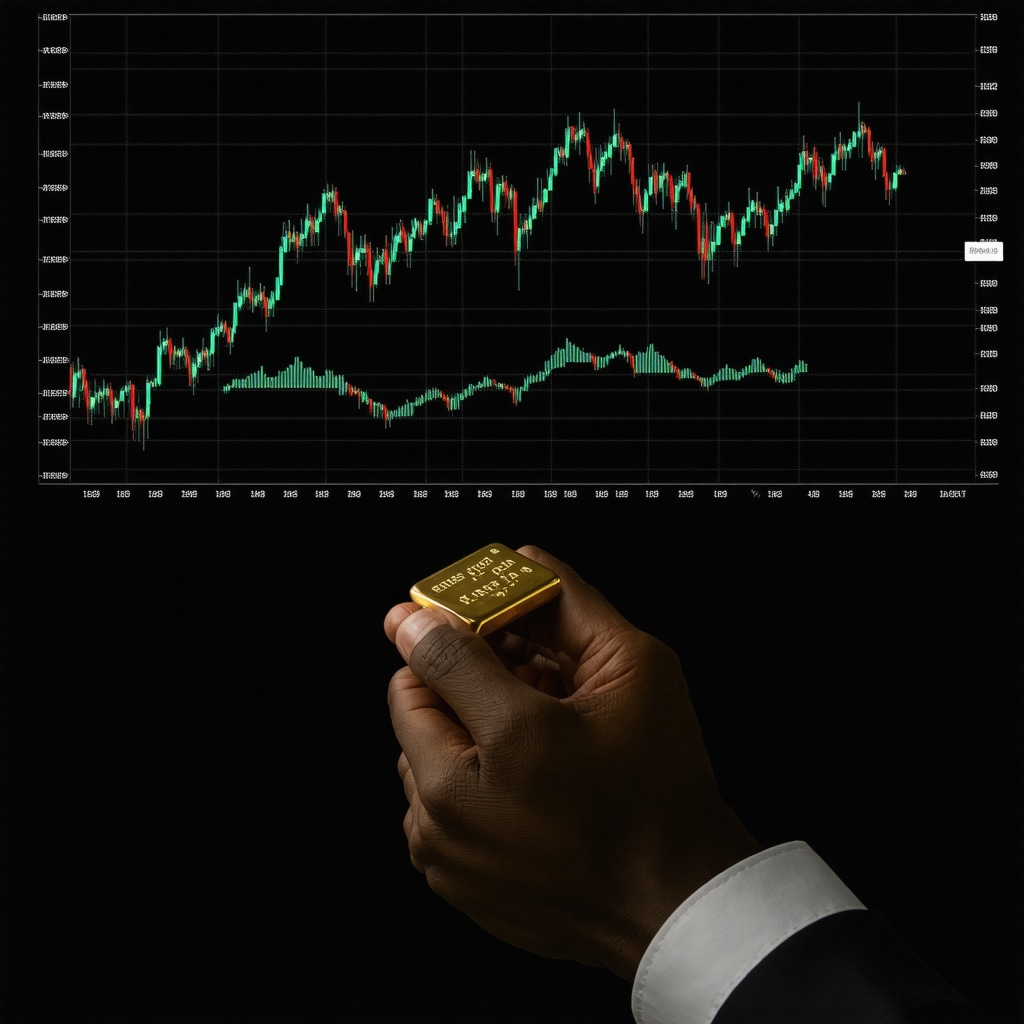Gold ETFs: Your New Best Friend in the Investment World?
Imagine you’re at a bustling cocktail party. Conversations buzz with talk of cryptocurrencies and volatile stocks, but you overhear a savvy investor whispering about gold ETFs as the unsung heroes of portfolio growth. Intrigued? You should be. Gold ETFs (Exchange-Traded Funds) offer a fascinating gateway for beginners to tap into the glittering world of gold without the cumbersome rituals of buying physical bars or coins.
Why Gold ETFs? Because Who Has Room for a Safe Full of Gold Bars?
Physical gold is heavy, requires secure storage, and let’s face it, not everyone has a secret vault beneath their floorboards. Gold ETFs, however, trade like stocks, allowing you to invest in gold’s value with the ease of a few clicks. They combine the stability of gold with the liquidity of the stock market — a perfect cocktail for portfolio growth, especially when balancing risk.
Is Investing in Gold ETFs Just Another Trend or a Timeless Strategy?
Great question! While the allure of gold is timeless, ETFs bring a modern twist that suits today’s fast-paced market environment. According to Investopedia’s expert analysis, gold ETFs provide low expense ratios and easy diversification, making them ideal for beginners who want a foothold in precious metals without the fuss.
Step-by-Step: How Do You Buy Gold ETFs Without Losing Your Shirt?
Start by opening a brokerage account if you don’t have one — think of it as your golden ticket. Next, research the top gold ETFs; some popular picks include SPDR Gold Shares (GLD) and iShares Gold Trust (IAU). Look for funds with strong liquidity, low fees, and solid track records. Then, decide how much of your portfolio you want to allocate—remember, balance is key. Finally, place your order and monitor your investment like a hawk, but don’t obsess!
Can Gold ETFs Really Hedge Against Market Volatility?
Absolutely. Gold has long been considered a safe haven during economic uncertainty. By weaving gold ETFs into your portfolio, you create a buffer against stock market dips and inflation. It’s like having a financial umbrella on a rainy day. For those keen on mastering this strategy, our detailed guide on building a resilient portfolio with gold ETFs offers invaluable insights.
Ready to dive deeper? Share your thoughts or questions below — let’s unravel the golden thread of investment success together. And if you want to explore more, check out our comprehensive tips on common pitfalls to avoid when investing in gold.
Beyond Basics: Advanced Gold ETF Strategies for Seasoned Investors
While beginners find gold ETFs appealing for their simplicity, savvy investors recognize the nuanced strategies that can elevate portfolio performance. Diversifying across various gold ETFs that track different underlying assets—such as physical gold bullion, gold futures, or gold mining equities—can optimize risk-adjusted returns. For instance, allocating a portion to ETFs like the VanEck Vectors Gold Miners ETF (GDX) exposes investors to leveraged gold price movements, while balancing with physical-backed ETFs stabilizes volatility.
Moreover, tactical rebalancing aligned with macroeconomic signals such as inflation reports, Federal Reserve announcements, and geopolitical tensions can enhance timing and capital allocation. Monitoring gold price forecasts and market indicators, as detailed in our expert insights on price movements, provides an analytical edge for making informed decisions in 2025’s dynamic market.
How Can Investors Leverage Central Bank Gold Purchases to Predict ETF Performance?
Central banks have increasingly been active participants in gold markets, often purchasing significant quantities as part of their reserve diversification strategy. These purchases influence global gold supply and demand dynamics, which directly affect gold ETF valuations. By analyzing central bank buying patterns and official disclosures, investors can anticipate price shifts and adjust ETF holdings accordingly.
According to the World Gold Council, central bank gold purchases grew substantially in recent years, signaling confidence in gold as a monetary asset amid economic uncertainties. This trend suggests that ETFs backed by physical gold may benefit from upward price pressure, especially during periods when central banks increase their holdings.
Integrating this macro perspective with technical analysis creates a robust framework for ETF portfolio construction, allowing investors to harness the interplay between policy-driven demand and market sentiment.
Mitigating Risks: What Should Investors Watch Out for With Gold ETFs?
Despite their advantages, gold ETFs come with risks worth noting. Market liquidity fluctuations can affect trade execution prices, particularly in volatile periods. Expense ratios, although generally low, vary between funds and can erode returns over time if not carefully considered. Additionally, factors such as counterparty risk and the structure of the ETF (physical-backed vs. synthetic) warrant scrutiny.
Investors should also be mindful of tax implications, which differ by jurisdiction and investment vehicle. Consulting with financial advisors to understand these nuances can prevent unintended consequences.
For a deeper dive into risk management and smart investment choices, our guide on choosing the best gold investment vehicles is a valuable resource.
Engage with Us: What advanced gold ETF strategies have you explored or found effective in 2025? Share your experiences and insights in the comments below. Your contributions enrich our community’s collective expertise.
Decoding the Tax Nuances and Regulatory Complexities of Gold ETFs in 2025
Investing in gold ETFs is not just about riding the waves of market volatility; it requires a sophisticated understanding of the tax and regulatory frameworks that shape returns. In many jurisdictions, gold ETFs are treated differently than traditional equity ETFs, often classified as collectibles or commodities, which can trigger higher capital gains tax rates upon sale. For instance, in the U.S., gains on gold ETFs held over one year may be taxed up to 28%, contrasting with the standard long-term capital gains rate capped at 20%. This subtle but critical distinction necessitates strategic holding periods and tax planning to optimize after-tax returns.
Moreover, regulatory shifts—such as changes in SEC oversight or amendments to commodity trading rules—can impact ETF structures and investor protections. Staying abreast of these changes is vital for investors aiming to preserve capital and comply with evolving mandates. The IRS Publication 550 offers an authoritative resource detailing how different types of gold investments are taxed, providing a valuable guide for investors navigating the tax landscape.
What Are the Most Effective Tax-Optimization Strategies for Gold ETF Investors?
Tax-loss harvesting stands out as a nuanced technique whereby investors intentionally realize losses on underperforming gold ETFs to offset gains elsewhere in their portfolios. This tactic can significantly reduce overall tax liabilities if executed with precision. Additionally, utilizing tax-advantaged accounts like IRAs or 401(k)s to hold gold ETFs can defer or eliminate capital gains taxes, depending on the account type and withdrawal rules.
Another advanced approach involves timing the sale of gold ETFs around fiscal year-end to manage taxable income brackets strategically. Coupling these strategies with consultation from a tax professional who understands precious metal investments can yield superior after-tax wealth accumulation.
Integrating Gold ETFs Within Multi-Asset Portfolios: Beyond Conventional Wisdom
While gold ETFs are often pigeonholed as safe havens, their role in a diversified portfolio can be far more dynamic. Employing a multi-factor analysis that incorporates macroeconomic indicators, interest rate cycles, and currency fluctuations can inform tactical shifts in gold ETF allocation. For example, during periods of rising real interest rates, gold’s opportunity cost increases, potentially reducing its attractiveness, whereas geopolitical tensions often spike demand, driving prices upward.
Seasoned portfolio managers increasingly utilize quantitative models that blend gold ETF exposures with other asset classes such as inflation-protected securities, foreign exchange assets, and commodity baskets. This holistic approach aims to capture asymmetric risk-return profiles and mitigate drawdowns during systemic shocks.
Exploring these multi-asset interactions through backtested simulations can reveal non-linear correlations and uncover hidden diversification benefits that traditional mean-variance frameworks might overlook.
How Do Currency Fluctuations Impact Gold ETF Performance for Global Investors?
For investors holding gold ETFs in a currency different from the U.S. dollar—the primary denomination of most gold ETFs—exchange rate volatility introduces an additional layer of complexity. A strengthening home currency against the dollar can erode gold ETF returns, while depreciation can amplify gains. This currency risk necessitates either hedging strategies or selective ETF choices that offer currency-hedged share classes.
Furthermore, geopolitical events influencing currency markets often correlate with gold price movements, creating intricate feedback loops that challenge simplistic investment assumptions.
Advanced investors might employ overlay strategies using currency futures or options to tailor their exposure, thereby refining portfolio risk profiles amid global uncertainty.
Ready to elevate your gold ETF investing strategy? Dive into our upcoming expert series where we dissect cutting-edge portfolio construction techniques and tax optimization methods tailored for 2025’s evolving landscape. Stay tuned and subscribe for insider insights that transform your investment approach.
Mastering Volatility: Leveraging Gold ETFs Amidst Global Economic Shifts
As 2025 unfolds with unpredictable geopolitical tensions and fluctuating monetary policies, gold ETFs stand at the crossroads of opportunity and risk. Beyond serving as mere safe havens, these instruments offer astute investors the ability to tactically harness volatility. Employing dynamic position sizing based on volatility indices like the VIX or the CBOE Gold ETF Volatility Index (GVZ) can provide a calibrated exposure that optimizes risk-adjusted returns. This approach requires continuous monitoring and agile portfolio adjustments, aligning with market pulse rather than static allocations.
How Can Sentiment Analysis and Alternative Data Enhance Gold ETF Trading Strategies?
In the era of big data, sophisticated investors are turning towards sentiment analysis derived from social media, news feeds, and even central bank communications to anticipate gold price movements and ETF performance. For instance, platforms like the Refinitiv MarketPsych Indices aggregate millions of online sources to quantify market mood, offering a predictive edge. Integrating these insights with traditional technical analysis enables traders to identify inflection points ahead of broad market moves, refining entry and exit timing for gold ETFs.
Moreover, alternative data such as satellite imagery tracking gold mining activity or freight movement can provide tangible signals about supply-side disruptions or increases. This multidimensional analysis enriches decision-making beyond classical economic indicators.
Embracing ESG and Ethical Dimensions in Gold ETF Selection
Environmental, Social, and Governance (ESG) considerations have become pivotal in discerning quality gold ETFs. Investors increasingly scrutinize the provenance of gold backing their ETFs, favoring funds that source from ethically mined gold and enforce stringent sustainability standards. ETFs like the best gold ETFs and mutual funds for steady portfolio growth often highlight ESG compliance as a competitive advantage.
This shift is more than ethical posturing; it reflects evolving regulatory pressures and growing consumer demand for responsible investing. Incorporating ESG metrics can mitigate reputational and operational risks, potentially leading to more resilient long-term returns.
Algorithmic Trading and Quant Models: The New Frontier for Gold ETFs
Quantitative strategies that utilize machine learning and algorithmic trading are revolutionizing how gold ETFs are managed and traded. By analyzing vast datasets encompassing price patterns, macroeconomic variables, and sentiment scores, these models identify subtle correlations and predictive signals often invisible to human traders. For example, adaptive algorithms can exploit intraday momentum shifts and mean reversion tendencies in gold ETF prices, optimizing trade executions.
However, these systems require rigorous backtesting and continuous refinement to adapt to evolving market regimes. For investors intrigued by computational methods, our guide on advanced gold trading techniques offers a comprehensive primer.
What Role Does Liquidity Fragmentation Play in Gold ETF Market Efficiency?
Liquidity fragmentation occurs when trading volume disperses across multiple venues or instruments, potentially causing price discrepancies and execution challenges. In gold ETFs, this phenomenon can arise due to overlapping listings, synthetic versus physical ETF structures, and cross-border trading. Such fragmentation may widen bid-ask spreads or introduce slippage, impacting investor returns, especially for large or frequent trades.
Understanding the interplay of liquidity pools and carefully selecting ETFs with consolidated trading volumes can mitigate these inefficiencies. Industry reports like those from the New York Stock Exchange detail how market fragmentation affects execution quality.
Engage with Our Expert Community: How have you incorporated advanced data analytics or ESG criteria in your gold ETF strategy? Share your cutting-edge approaches and questions below to foster a vibrant exchange of ideas. For a deeper dive into forecasting and tactical gold ETF allocation, explore our expert resources on gold price forecasts and market dynamics.
Expert Insights & Advanced Considerations
The Interplay of Central Bank Purchases and Gold ETF Valuations
Central banks continue to be pivotal in shaping gold market dynamics. Their strategic accumulation of gold reserves signals confidence in gold’s monetary value, often leading to sustained upward pressure on gold ETF prices. Investors who monitor these macroeconomic trends can anticipate shifts in ETF performance and adjust their portfolios accordingly. For a detailed exploration, see our analysis on gold demand trends in 2025.
Incorporating Sentiment Analysis and Alternative Data for Tactical Trading
The rise of big data analytics offers gold ETF investors a competitive edge. By integrating sentiment indicators from platforms aggregating social media and financial news, alongside unconventional data like satellite imagery tracking mining activity, traders can identify market inflection points ahead of traditional signals. This multi-dimensional approach enriches decision-making and timing, as discussed in our guide on proven gold trading techniques.
Advanced Tax Optimization Strategies in Gold ETF Investing
Understanding jurisdiction-specific tax treatment of gold ETFs is critical. Techniques such as tax-loss harvesting and using tax-advantaged retirement accounts can significantly enhance after-tax returns. Strategic sale timing aligned with fiscal calendars also plays a vital role. Investors should consult experts and refer to authoritative resources like IRS Publication 550 to navigate complexities effectively.
Multi-Asset Portfolio Integration Beyond Traditional Safe-Haven Roles
Gold ETFs, when analyzed through macroeconomic variables and combined with assets like inflation-protected securities and currency instruments, can offer asymmetric risk-return profiles that traditional mean-variance frameworks may overlook. Utilizing quantitative models to detect non-linear correlations enhances portfolio resilience amid systemic market shocks. Explore more on tactical allocation in our article on building a resilient portfolio with gold ETFs.
Liquidity Fragmentation and Its Impact on Gold ETF Market Efficiency
Market fragmentation across exchanges and ETF structures can lead to wider bid-ask spreads and potential execution slippage. Savvy investors mitigate these risks by selecting ETFs with consolidated liquidity pools and understanding venue-specific trading nuances, thereby preserving returns especially in volatile environments.
Curated Expert Resources
- World Gold Council – Gold Demand Trends: Comprehensive reports offering deep insights into global gold supply, demand, and central bank activity, essential for understanding foundational market drivers. (Learn more)
- Refinitiv MarketPsych Indices: Advanced sentiment analytics aggregating news and social media data, providing predictive signals for gold price movements and ETF trading strategies.
- IRS Publication 550: Authoritative guidance on tax treatment of precious metals and ETFs in the U.S., a crucial resource for investors seeking tax efficiency. (Official resource)
- Buying Gold Now – Proven Gold Trading Techniques: Practical and advanced strategies for navigating gold market volatility and optimizing ETF trading. (Explore techniques)
- Buying Gold Now – Gold ETF Strategies for Resilient Portfolios: In-depth coverage of portfolio construction tactics incorporating gold ETFs for long-term growth and risk mitigation. (Read the guide)
Final Expert Perspective
Gold ETFs remain a sophisticated yet accessible vehicle for navigating 2025’s complex investment landscape. From the subtle influence of central bank gold acquisitions to the cutting-edge application of sentiment analysis and tax optimization, mastering these dimensions is vital for maximizing portfolio resilience and returns. Integrating gold ETFs thoughtfully within diversified, multi-asset strategies further enhances their value beyond traditional safe-haven perceptions. We invite seasoned investors and newcomers alike to deepen their understanding by engaging with our expert resources and sharing their own insights. To elevate your gold ETF strategy amid evolving market dynamics, explore our advanced discussions on gold price forecasts and market dynamics and contribute your perspective to this vibrant community.











I really appreciated the detailed step-by-step guide on how to buy gold ETFs. As someone new to investing, I found the recommendations on researching funds like GLD and IAU particularly useful. The point about balancing allocations and monitoring investments without obsessing is a helpful reminder that patience and strategy are key.
One aspect I wonder about is the tax efficiency of holding gold ETFs in different account types. Have you found that using retirement accounts significantly improves after-tax returns compared to regular trading accounts? Also, with so many evolving strategies, what are some common mistakes beginners tend to overlook when incorporating gold ETFs into a diversified portfolio? Sharing personal experiences or advice from seasoned investors could really help newcomers navigate these waters more confidently. Overall, this article has clarified many misconceptions I’ve had about gold investments and really encourages me to consider adding gold ETFs as part of my long-term strategy.
This post offers some really insightful strategies for integrating gold ETFs into a diversified investment portfolio. I agree that balancing risk and monitoring your investments without becoming obsessive are crucial, especially with the complexity of macroeconomic factors influencing gold prices. One thing I’ve observed is that during times of geopolitical tension or inflation spikes, gold ETFs tend to perform well, which makes them an appealing hedge.
However, the aspect of tax implications mentioned is often overlooked by new investors. In my experience, utilizing tax-advantaged accounts like IRAs for holding gold ETFs can significantly improve after-tax returns, especially if held long-term. But it’s also important to understand local tax laws and potential reporting requirements, which can vary.
For those just starting out, do you recommend focusing on physical gold or more on ETFs, considering the liquidity and ease of trading? I’d love to hear other investors’ experiences with different account types and how they’ve managed tax strategies effectively.